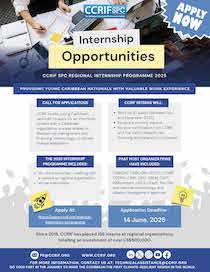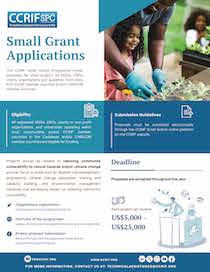CCRIF prepares country risk profiles for each member country for tropical cyclones, earthquakes and excess rainfall. The profiles provide an outline of the hazard characteristics and risks for the country as well as economic loss information used by our catastrophe models. The profiles have been designed to provide this information in a simple, accurate and robust manner covering the demographic, geological and economic characteristics of their territories, whilst at the same time assessing the impacts of historical events that may have caused damage to infrastructure, population and the economy. The profiles act as the basis for pricing for countries’ CCRIF policies.
As part of its thrust to continuously improve the quality of products and services it provides to members, CCRIF makes improvements to its models from time to time based on new and emerging trends in the science of model development as well as the availability of new information and data to enhance the quality of the models and the products it provides. For more information on CCRIF’s models, please see the publication, “The Evolution of CCRIF’s Parametric Insurance Models”
CCRIF has produced new country risk profiles for tropical cyclones and earthquakes (based on upgrades to the SPHERA model) and for excess rainfall (based on the new XSR 3.0 model). These models underpin countries’ policies for 2023/24.
The risk profiles are proprietary documents that CCRIF provides to the government of each country. If the government gives permission to make these documents publicly available, CCRIF places the profiles on the CCRIF website.
The following annexes for the country risk profiles provide information about the underlying models and the historical events database:
- EQ Annex 1: the upgraded SPHERA Model for earthquake
- EQ Annex 2: the upgraded SPHERA Model for earthquake - Historical events database
- TC Annex 1: the upgraded SPHERA Model for tropical cyclone
- TC Annex 2: the upgraded SPHERA Model for tropical cyclone - Historical events database
- XSR Annex 1: the XSR 3.0 Model for excess rainfall
- XSR Annex 2: the XSR 3.0 Model for rainfall - Historical events database
The main objective of CCRIF’s country risk profiles is to provide a clear picture of the key risks that the country faces in order to guide national catastrophe risk management and inform decision making for both risk reduction and risk transfer (via CCRIF coverage and other mechanisms that may be available). They provide the basis for CCRIF to discuss coverage options with each country individually and to underwrite country policies once coverage levels have been agreed. As such, these profiles present losses for the country at different probabilities of occurrence (more precisely referred to as probabilities of exceedance). The exceedance probabilities act as the basis for pricing of CCRIF’s parametric insurance policies and represents the established way of quantifying risk.
The new SPHERA model for TC includes:
- A new tropical cyclone stochastic catalogue, that uses state-of-the-art techniques for stochastic tropical cyclone generation -- with more events (the equivalent of 50,000 years) and separate catalogues for the Atlantic Basin and the Pacific Basin.
- New loss data as reported from the most recent tropical cyclones, including Elsa in 2021 and Dorian in 2019, which allowed for the recalibration of vulnerability functions for 12 member countries.
- A new policy endorsement for localized events (called the Localized Damage Index (LDI)) for tropical cyclone events where losses are highly concentrated in small sections of a country.
The new SPHERA Model for EQ includes:
- More recent data about seismicity and faulting systems for Jamaica, Haiti, and the Cayman Islands – including an updated earthquake catalogue up to December 2021
- Reclassification of the vulnerability classes for Jamaica.
The SPHERA EQ model was updated for Jamaica, Haiti, and the Cayman Islands. These three countries share some of the same fault systems that contribute to their level of earthquake hazard.
The new XSR 3.0 model includes:
- Use of two new WRF configurations at high resolution (approximately 4 km – compared with 8-km confi gurations previously used), based on those used by the Caribbean Institute for Meteorology and Hydrology (CIMH) and Guatemala’s Institute for Seismology, Volcanology, Meteorology and Hydrology (INSIVUMEH); the WRF is a climatic-meteorological model developed by NOAA and is one of the sources of rainfall data used in the CCRIF model.
- Inclusion of IMERG to supplement CMORPH as one of the sources of data for the model; NASA’s new IMERG system combines information from the current constellation of satellites to estimate precipitation. This algorithm is particularly valuable over areas that lack precipitation-measuring instruments on the ground.
- Use of data from rainfall events that occurred over the period 2019 to 2021 in the risk analysis.
- The revision and optimization of the loss calculation approach to take into account the new model configurations to support enhanced performance.
- Adjustment of the vulnerability curves to reflect the costliest events, using the latest available data.
- Inclusion of a soil crusting effect to detect rain events that happen after a long drought, when exceptionally dry soil contributes to poor absorption ability.
- The addition of two new policy endorsements, which introduce the ability to detect excess rainfall events that occur when the soil is saturated (“wet season trigger” - WST) and extreme localized rainfall events (“localized event trigger” - LET).
The development of the CCRIF catastrophe risk profiles is an important contribution to national and regional risk management institutions through the collection of a significant set of detailed databases on national catastrophe risk exposures in member states. These risk profiles facilitate increased knowledge of the extent of catastrophe risk facing CCRIF member countries and can help governments better adapt to known threats and mitigate against future threats. The data contained in these profiles can also be used by countries in their development planning frameworks and in the preparation of national disaster management plans for example.





